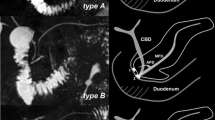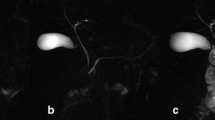Abstract
Objectives
To assess the value of secretin during magnetic resonance cholangiopancreatography (MRCP) in demonstrating communication between cystic lesions and the pancreatic duct to help determine the diagnosis of side-branch intraductal papillary mucinous neoplasm (SB-IPMN).
Methods
This is an IRB-approved, HIPAA-compliant retrospective study of 29 SB-IPMN patients and 13 non-IPMN subjects (control) who underwent secretin-enhanced MRCP (s-MRCP). Two readers blinded to the final diagnosis reviewed three randomised image sets: (1) pre-secretin HASTE, (2) dynamic s-MRCP and (3) post-secretin HASTE. Logistic regression, generalised linear models and ROC analyses were used to compare pre- and post-secretin results.
Results
There was no significant difference in median scores for the pre-secretin [reader 1: 1; reader 2: 2 (range -2 to 2)] and post-secretin HASTE [reader 1: 1; reader 2: 1 (range -2 to 2)] in the SB-IPMN group (P = 0.14), while the scores were lower for s-MRCP [reader 1: 0.5 (range -2 to 2); reader 2: 0 (range -1 to 2); P = 0.016]. There was no significant difference in mean maximum diameter of SB-IPMN on pre- and post-secretin HASTE, and s-MRCP (P > 0.05).
Conclusion
Secretin stimulation did not add to MRCP in characterising pancreatic cystic lesions as SB-IPMN.
Key Points
• Magnetic resonance cholangiopancreatography (MRCP) is used to evaluate pancreatic cystic lesions.
• Intraductal papillary mucinous neoplasm (IPMN) is a type of pancreatic cystic neoplasm.
• Secretin administration does not facilitate the diagnosis of IPMN on MRCP.



Similar content being viewed by others
Abbreviations
- MRCP:
-
magnetic resonance cholangiopancreatography
- S-MRCP:
-
secretin-enhanced magnetic cholangiopancreatography
- IPMN:
-
intraductal papillary mucinous neoplasm, SB-IPMN, side-branch intraductal papillary mucinous neoplasm
- MDCT:
-
multidetector computed tomography
- HASTE:
-
half-Fourier acquisition single-shot turbo spin-echo
- MPD:
-
main pancreatic duct
References
Rickaert F, Cremer M, Devière J et al (1991) Intraductal mucin-hypersecreting neoplasms of the pancreas. A clinicopathologic study of eight patients. Gastroenterology 101:512–519
Kloppel G, Solcia E, Longnecker DS, Capella C, Sobin LH (1996) Histological typing of tumours of the exocrine pancreas. In: World Health Organization International Histological Classification of Tumors, 2nd edn. Springer, Berlin, pp 11–20
Adsay NV (2007) Cystic lesions of the pancreas. Mod Pathol 20:S71–S93
Tanaka M, Fernández-del Castillo C, Adsay V et al (2012) International Association of Pancreatology. International consensus guidelines 2012 for the management of IPMN and MCN of the pancreas. Pancreatology 12:183–197
Berland LL, Silverman SG, Gore RM et al (2010) Managing incidental findings on abdominal CT: white paper of the ACR incidental findings committee. J Am Coll Radiol 7:754–773
Guarise A, Faccioli N, Ferrari M et al (2008) Evaluation of serial changes of pancreatic branch duct intraductal papillary mucinous neoplasms by follow-up with magnetic resonance imaging. Cancer Imaging 8:220–228
Lim JH, Lee G, Oh YL (2001) Radiologic spectrum of intraductal papillary mucinous tumor of the pancreas. Radiographics 21:323–337
Pedrosa I, Boparai D (2010) Imaging considerations in intraductal papillary mucinous neoplasms of the pancreas. World J Gastrointest Surg 2:324–330
Kalb B, Sarmiento JM, Kooby DA, Adsay NV, Martin DR (2009) MR imaging of cystic lesions of the pancreas. Radiographics 29:1749–1765
Waters JA, Schmidt CM, Pinchot JW et al (2008) CT vs MRCP: optimal classification of IPMN type and extent. J Gastrointest Surg 12:101–109
Manfredi R, Graziani R, Motton M et al (2009) Main pancreatic duct intraductal papillary mucinous neoplasms: accuracy of MR imaging in differentiation between benign and malignant tumors compared with histopathologic analysis. Radiology 253:106–115
Carbognin G, Pinali L, Girardi V, Casarin A, Mansueto G, Mucelli RP (2007) Collateral branches IPMTs: secretin-enhanced MRCP. Abdom Imaging 32:374–380
Chey WY, Chang TM (2003) Secretin, 100 years later. J Gastroenterol 38:1025–1035
Sanyal R, Stevens T, Novak E, Veniero JC (2012) Secretin-enhanced MRCP: review of technique and application with proposal for quantification of exocrine function. AJR Am J Roentgenol 198:124–132
Tirkes T, Sandrasegaran K, Sanyal R et al (2013) Secretin-enhanced MR cholangiopancreatography: spectrum of findings. Radiographics 33:1889–1906
Matos C, Metens T, Deviere J et al (1997) Pancreatic duct: morphologic and functional evaluation with dynamic MR pancreatography after secretin stimulation. Radiology 203:435–441
Hellerhoff KJ, Helmberger H 3rd, Rösch T, Settles MR, Link TM, Rummeny EJ (2002) Dynamic MR pancreatography after secretin administration: image quality and diagnostic accuracy. AJR Am J Roentgenol 179:121–129
Fukukura Y, Fujiyoshi F, Sasaki M, Nakajo M (2002) Pancreatic duct: morphologic evaluation with MR cholangiopancreatography after secretin stimulation. Radiology 222:674–680
Fernádez-del Castillo C, Adsay NV (2010) Intraductal papillary mucinous neoplasm of the pancreas. Gastroenterology 139:708–713
Acknowledgments
The scientific guarantor of this publication is Namita S. Gandhi, MD. The authors of this manuscript declare no relationships with any companies, whose products or services may be related to the subject matter of the article. The authors state that this work has not received any funding. One of the authors has significant statistical expertise. Institutional Review Board approval was obtained. Written informed consent was waived by the Institutional Review Board. Methodology: retrospective, diagnostic, performed at one institution
Author information
Authors and Affiliations
Corresponding author
Rights and permissions
About this article
Cite this article
Purysko, A.S., Gandhi, N.S., Walsh, R.M. et al. Does secretin stimulation add to magnetic resonance cholangiopancreatography in characterising pancreatic cystic lesions as side-branch intraductal papillary mucinous neoplasm?. Eur Radiol 24, 3134–3141 (2014). https://doi.org/10.1007/s00330-014-3355-y
Received:
Revised:
Accepted:
Published:
Issue Date:
DOI: https://doi.org/10.1007/s00330-014-3355-y




